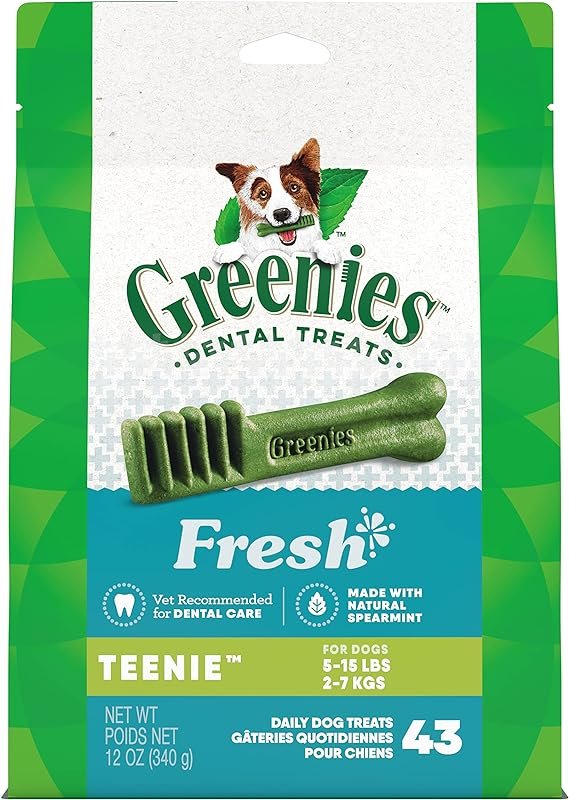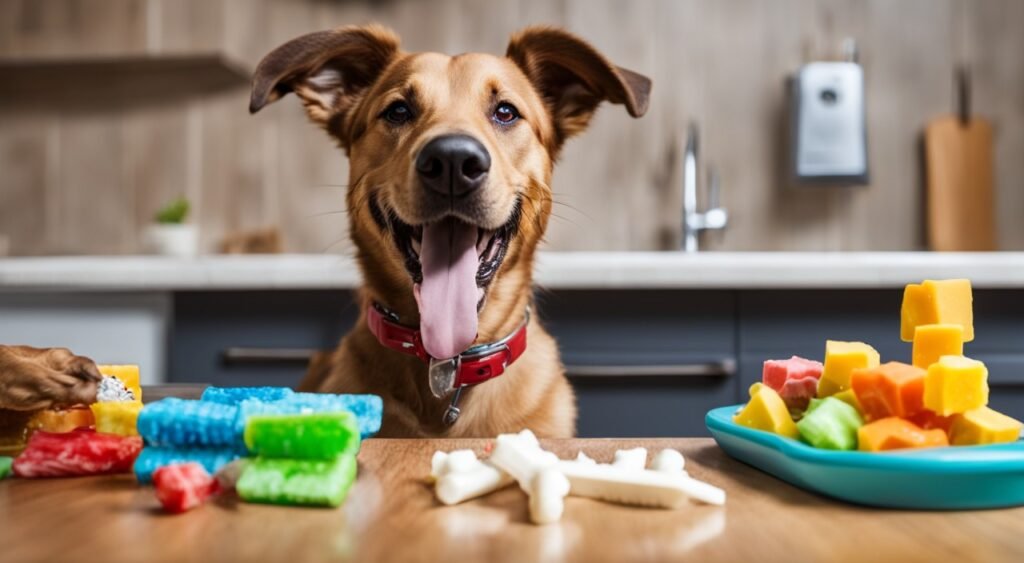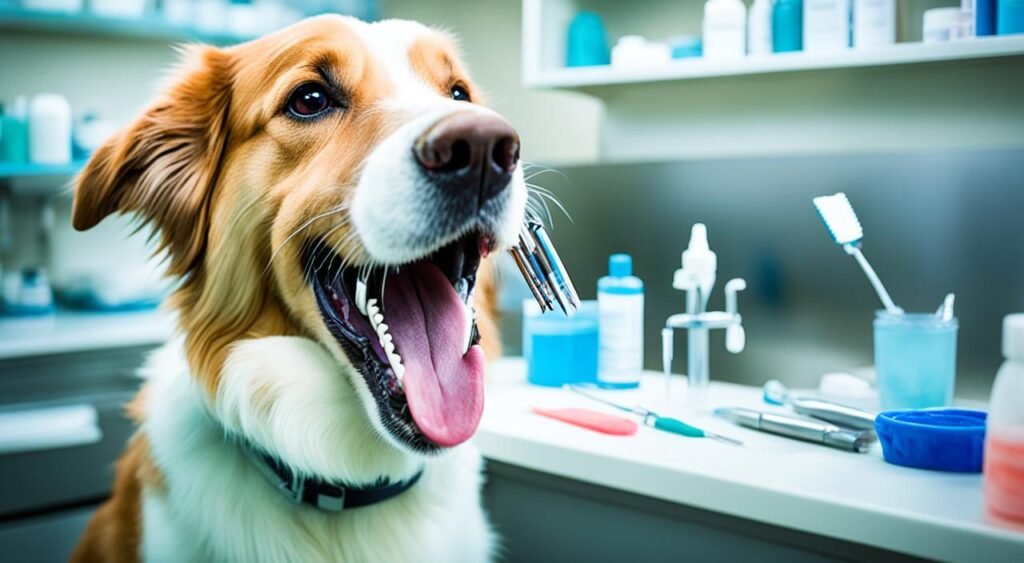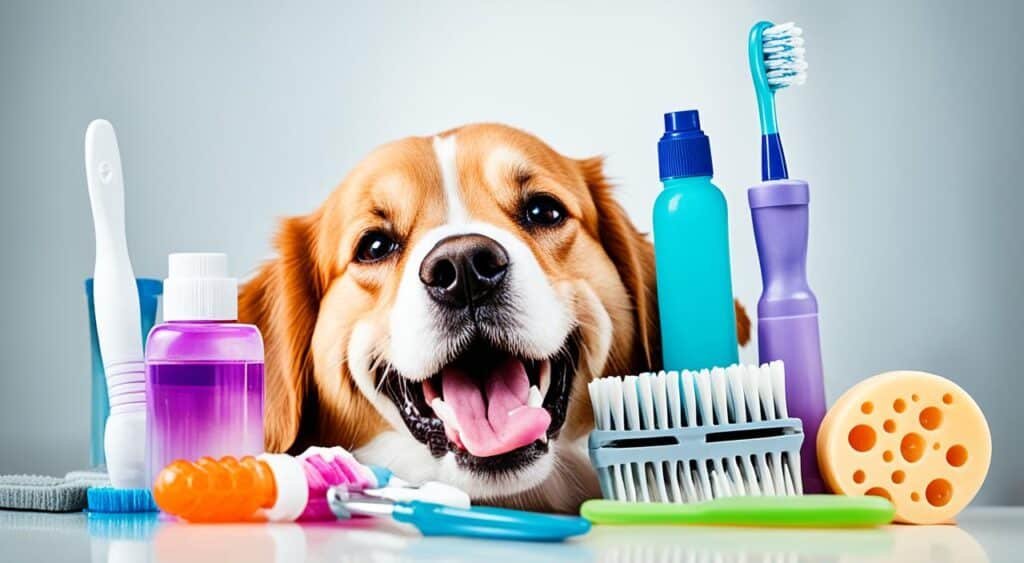Ever thought about your dog’s smile hiding dental problems? It’s hard to believe, but healthy dog teeth matter a lot. They’re not only for looking good. Good dental health is vital for your pet’s overall well-being.
Just like humans, dogs need the right dental care to stay happy and healthy. It’s important to learn how to keep your dog’s teeth clean and strong. Here are some effective tips for taking care of your dog’s dental health.
- Understanding the Importance of Canine Oral Hygiene
- Dog Teeth: How to Start a Brushing Routine
- Maximizing Dental Care with Dog Tooth Wipes and Water Additives
- Maintaining Dental Health with Dog Dental Treats and Chews
- Professional Dog Teeth Cleaning: Is it Worth the Cost?
- The Role of Diet and Nutrition in Oral Hygiene for Dogs
- Crafting a Complete Dental Care Plan for Your Dog
Understanding the Importance of Canine Oral Hygiene
Keeping your furry friend’s teeth clean is as important as their vet visits. Dogs can get oral diseases just like people. This can cause serious health problems. Let’s explore why periodontal disease in dogs is serious and what happens when you ignore your dog’s teeth.
The Prevalence of Periodontal Disease in Dogs
Periodontal disease can really hurt your dog’s mouth and health if it gets worse. Sadly, it’s very common. Most dogs start to show signs before they are three years old. Without stopping it early, plaque and tartar can cause infections, tooth decay, and even tooth loss.
| Age Group | Percentage Affected by Periodontal Disease |
|---|---|
| 1-3 years | Early signs in 80% of dogs |
| Over 3 years | Advanced disease in 70% of dogs |
Consequences of Neglected Dog Dental Health
Ignoring your dog’s dental health is bad. It can lead to worse problems than just bad breath. Bacteria from the mouth can get into the blood and hurt organs like the heart and kidneys. Pain from dental problems can change your dog’s behavior and lower their quality of life.
- Infection and inflammation
- Tooth loss and difficulty eating
- Systemic health problems including heart and kidney disease
By taking care of your dog’s teeth, you can avoid these problems. Your pet can live a happy life without pain. Remember, canine oral hygiene is essential for your dog’s health and happiness.
Dog Teeth: How to Start a Brushing Routine
Starting a brushing routine is essential for your dog’s dental health. It keeps their teeth clean and prevents diseases. It’s important to learn how to brush and choose the right toothpaste.

Greenies TEENIE Natural Dental Care Dog Treats
- Greenies Treats for Dogs are veterinarian recommended and VOHC accepted (Veterinary Oral Health Council)
- Bursting with breath-freshening mint flavor, treat your small dog fantastically with these natural dog breath treats
Selecting the Right Dog Toothpaste
Dog toothpaste is made safe for pets to swallow and tastes good to them. Look for enzyme-containing toothpastes to fight plaque and tartar. Avoid ones with xylitol as it’s harmful. Always choose toothpaste approved by vets for your pet’s safety.
Introducing Your Dog to Toothbrushing
Teaching your dog to brush teeth takes patience. Let them taste the toothpaste from your finger first. Then, use a special dog toothbrush to gently clean a couple of teeth. Slowly, brush more teeth, making sure your dog is happy.
| Week | Goal | Tips |
|---|---|---|
| 1 | Adjust to toothpaste flavor | Let your dog lick toothpaste from your finger. |
| 2-3 | Introduce the toothbrush | Allow your dog to sniff and nibble the toothbrush without toothpaste. |
| 4 | First brushing experience | Brush one or two teeth with toothpaste, praising your dog throughout the process. |
| 5-6 | Expand brushing area | Gradually increase the number of teeth brushed, building up to a full routine. |
| 7+ | Regular brushing habit | Maintain a consistent routine, ideally brushing your dog’s teeth daily. |
With the right routine, toothbrushing will be enjoyable for you and your dog. Always make it a positive experience. This builds good dental habits for their health and happiness.
Maximizing Dental Care with Dog Tooth Wipes and Water Additives
Keeping your dog’s mouth healthy is key. Thanks to advances in vet care, we now understand how crucial regular oral hygiene is for dogs. Using dog tooth wipes and water additives can really help. Let’s see how these tools make dental care easier.
Using Dental Wipes for Plaque Removal
Dog tooth wipes are perfect for keeping your dog’s teeth clean between brushings. They’re soaked with special ingredients that fight plaque. Just a quick swipe over your dog’s teeth and gums can cut down on harmful bacteria. Using them daily adds an easy step to your pet’s dental routine. Here’s a hint on fitting them into your dog care plans.

Benefits of Water Additives for Dog Oral Hygiene
Water additives make improving your dog’s dental health easy. Just pour them into your dog’s water bowl. These products are designed to combat plaque and tartar. With regular use, they keep your dog’s mouth fresh and clean. This means your furry friend gets dental care benefits all day long.
By using both dog tooth wipes and water additives, you create a full dental care plan. This duo makes keeping your dog’s teeth shiny a breeze. Always use these products as directed and talk to your vet for the best advice. This way, your dog’s smile stays bright and healthy.
Maintaining Dental Health with Dog Dental Treats and Chews
Adding dog dental treats and dog dental chews to your pet’s daily care can be fun and helpful. These items help lessen plaque and tartar, make breath fresher, and teeth stronger. But, it’s crucial to pick the right ones with so many choices out there. Let’s dig into the details to keep your dog’s smile shining.
- Look for treats and chews that have received the Veterinary Oral Health Council (VOHC) seal of approval.
- Choose treats that match your dog’s size and chewing style to prevent choking hazards or digestive issues.
- Consider your dog’s dietary needs, such as grain-free or limited-ingredient treats, to avoid allergic reactions.
- Incorporate dental treats and chews into your dog’s routine, but remember they are not a substitute for regular brushing.
Experts and vets say that dog dental chews and treats can be part of good dental care. Let’s see what some top brands offer:
| Brand | Product Type | Key Benefits | Active Ingredients |
|---|---|---|---|
| Greenies | Dental Treats | Plaque and Tartar Control | Light Chew Texture, Natural Ingredients |
| Pedigree Dentastix | Dental Chews | Triple Action Clean | X-Shape Design, Clinically Proven Texture |
| Blue Buffalo Dental Bones | Natural Chews | Joint Health Support | Glucosamine, Chondroitin |
| Virbac C.E.T. Chews | Enzymatic Chews | Enzymatic Cleaning Action | Dual-Enzyme System |
For your pet’s best dental health, use dog dental treats and chews with regular vet visits. They are an extra help, not the only care needed. Always watch your dog with these treats to make sure they’re chewing safely. With the correct use, these treats can help keep your dog’s teeth healthy for life.
Professional Dog Teeth Cleaning: Is it Worth the Cost?
Should you pay for professional dog teeth cleaning? This question isn’t easy. You must think about the cleaning method and compare it with taking care of your dog’s teeth at home. Many pet owners find themselves deciding between pro services and DIY teeth cleaning.
What Happens During a Professional Cleaning?
A pro cleaning for your dog means they get a deep clean. This includes removing plaque and tartar, polishing teeth, and checking their mouth health. All of this happens under anesthesia to keep your pet safe and pain-free, which adds to the cost.
Comparing At-home Care and Professional Solutions
Brushing your dog’s teeth daily and using dental chews are cheaper ways to prevent dental problems. But, these at-home methods can’t get rid of tough tartar. They also can’t help spot health issues that a vet might find during a professional cleaning.
Let’s look at the pros and cons of both methods:
- Cost-effectiveness: DIY care is easier on your wallet and can mean fewer professional cleanings.
- Efficacy: Nothing beats the deep clean of a professional session.
- Convenience: At-home care needs daily effort, while professional visits are less frequent but need a vet appointment.
- Health monitoring: Vets can find early dental problems during a cleaning, which can save you money later on.
Deciding on professional dental cleaning for your dog means thinking about their long-term health. It’s about balancing the costs with the benefits and the peace of mind you get.
The Role of Diet and Nutrition in Oral Hygiene for Dogs
Keeping your dog’s smile bright is vital. The right diet and nutrition for dogs are key, just like daily brushing. The food your dog eats is very important for their dental health. Let’s look at how to pick the best dental diet to keep your pet’s teeth healthy.
Choosing the Right Dental Diet for Your Dog
Dental diets help reduce plaque and tartar on your dog’s teeth. They have bigger kibble or a special texture to clean teeth while your dog chews. Here’s how to pick the right food for your dog’s teeth:
- Choose diets approved by oral health councils or similar groups.
- Talk to your vet about the best dental diets for your dog’s size and breed.
- Make sure the diet meets all your dog’s nutritional needs.
Safe and Healthy Foods that Promote Clean Teeth
Some foods for clean teeth can help your dog’s dental care routine. Though not a substitute for brushing, these foods aid in dental hygiene:
| Food | Benefits |
|---|---|
| Carrots | Rich in fiber and scrub teeth clean. |
| Apples | Contain malic acid, boost saliva, and freshen breath. |
| Celery | Works like a toothbrush, removing food and bacteria. |
| Raw Bones | Chewing removes plaque. Watch your dog and choose correct size. |
| Coconut Oil | Its antibacterial properties can be added to food or homemade toothpaste. |
Choose your dog’s diet and nutrition with a focus on dental health. Also, add foods for clean teeth to their diet. This, along with regular brushing and vet visits, helps your dog keep a healthy smile.
Crafting a Complete Dental Care Plan for Your Dog
To keep your dog healthy, you need a complete dental care plan. This means more than just the basics. You need a consistent routine that includes daily brushing, the right products, and a good diet. These steps are key for a dental care plan for dogs.

Start by brushing your dog’s teeth every day. Use special dog toothpaste and introduce brushing slowly. This makes it easy for both of you. Also, use dog tooth wipes and water additives to help keep their mouth clean. Offer them dental treats and chews too. These help reduce plaque. But, don’t forget that brushing their teeth daily is still a must.
Don’t overlook professional cleanings in your dental care plan for dogs. Even with all the care at home, your dog needs check-ups. A vet can remove tartar and check your dog’s oral health. A mix of home care, vet visits, and a healthy diet keeps your dog’s mouth healthy. With these steps, you can prevent dental problems and keep your dog happy and healthy.
FAQ
Why is dental care important for dogs?
Dogs need dental care to stay healthy. Without it, they can get diseases that hurt their gums and teeth. If ignored, these issues can get worse.
What is periodontal disease in dogs?
Periodontal disease is common in dogs. It causes their gums to get inflamed. If not treated, it can make them lose their teeth and lead to other health problems.
What are the risks of neglecting my dog’s dental health?
If you don’t take care of your dog’s teeth, they could get cavities and gum disease. They might have bad breath, pain, and lose their teeth. This could also affect their heart, liver, and kidneys.
How do I start a toothbrushing routine for my dog?
To brush your dog’s teeth, get toothpaste made for them and a soft toothbrush. Use the toothpaste slowly. Make sure your dog is happy during the process.
What kind of toothpaste should I use for my dog?
Use toothpaste made just for dogs. Do not use human toothpaste. It can harm them if they swallow it.
How can I introduce my dog to toothbrushing?
Start by showing your dog the toothpaste. Let them taste it. Then, softly rub their teeth with your finger. Slowly move on to using a toothbrush. Always be gentle and give them praise.
How do I use dental wipes for my dog?
Dental wipes help clean your dog’s teeth. Wrap one around your finger. Then, softly rub their gums and teeth. Focus on the back teeth where plaque builds up.
What are the benefits of using water additives for my dog’s oral hygiene?
Water additives keep your dog’s mouth healthy. They reduce plaque and make breath smell better. Just add it to their water.
How can dental treats and chews help maintain my dog’s dental health?
Dental treats and chews clean your dog’s teeth. They get rid of plaque and make gums healthy. Choose treats that are made for cleaning teeth.
What happens during a professional dental cleaning for dogs?
For a dental cleaning, dogs are put to sleep to keep them calm. The vet cleans their teeth well. Sometimes they even remove bad teeth.
Should I opt for professional dental cleaning or stick to at-home care?
Both at-home care and vet cleanings are important. They work best together. Talk to your vet to decide what’s best for your dog.
How does diet and nutrition affect my dog’s oral hygiene?
What your dog eats matters to their dental health. Certain foods can help keep their teeth clean and reduce plaque.
What is a dental diet for dogs?
A dental diet for dogs helps keep their teeth healthy. This food is shaped to clean teeth while they eat. It also has nutrients they need.
What are some safe and healthy foods that promote clean teeth in dogs?
Foods like apples and carrots can clean your dog’s teeth. Raw bones and dental chews also work well. Always watch them with bones.
How do I craft a comprehensive dental care plan for my dog?
For good dental care, brush your dog’s teeth and use dental wipes. Add water additives and give them dental treats. Get vet cleanings and feed them right. Ask your vet for advice.








